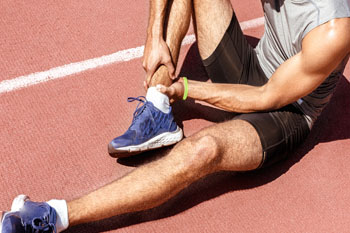Foot Care for Athletes
Sports Activities
 Millions of American children participate in team and individual sports, many of them outside the school system, where advice on conditioning and equipment is not always available.
Millions of American children participate in team and individual sports, many of them outside the school system, where advice on conditioning and equipment is not always available.
Parents should be concerned about children's involvement in sports that require a substantial amount of running and turning, or involve contact.
Protective taping of the ankles is often necessary to prevent sprains or fractures. Parents should consider discussing these matters with their family podiatrist if they have children participating in active sports.
Sports-related foot and ankle injuries are on the rise as more children actively participate in sports.
First Step -- See Your Doctor
Before you start a fitness program, you should consult a physician for a complete physical, and a podiatric physician for a foot exam. This is especially so if you are over 60, haven't had a physical checkup in the last year, have a disease or disability, or are taking medication. It is recommended that if you are 35-60, substantially overweight, easily fatigued, smoke excessively, have been physically inactive, or have a family history of heart disease, you should consult a physician.
Once you have been cleared to begin exercise, your first goal is to make physical activity a habit. The goals for your activity program, at whatever level of fitness you presently have, are (a) 30 minutes of exercise, (b) four times a week, (c) at a comfortable pace. Stay true to these goals, and you will become fit.
Fitness Planning
Striving for physical fitness is not to be taken lightly. The President's Council on Physical Fitness and Sports cautions that unless you are convinced of the benefits of fitness and the risks of unfitness, you will not succeed. Patience is essential. Don't try to do too much too soon; give yourself a chance to improve.
As you exercise, pay attention to what your body, including your feet, tells you. If you feel discomfort, you may be trying to do too much too fast. Ease up a bit or take a break and start again at another time. Drink fluids on hot days or during very strenuous activities, to avoid heat stroke and heat exhaustion.
Suiting Up and Shoe Up
For your fitness success, you should wear the right clothes and the proper shoes. Wear loose-fitting, light-colored and loosely woven clothing in hot weather and several layers of warm clothing in cold weathe.
n planning for your equipment needs, don't ignore the part of your body that takes the biggest beating -- your feet. Podiatric physicians recommend sturdy, properly fitted athletic shoes of proper width, with leather or canvas uppers, soles that are flexible (but only at the ball of the foot), cushioning, arch supports, and room for your toes. They also suggest a well-cushioned sock for reinforcement, preferably one with an acrylic fiber content so that some perspiration moisture is "wicked" away.
Because of the many athletic shoe brands, and styles within those brands, you may want to ask a podiatrist to help you select the shoe you need. Generally speaking, athletic shoes are available in sport-specific styles or cross-training models.
Foot Care for Fitness
The importance of foot care in exercising is stressed by the American Podiatric Medical Association. According to the American Academy of Podiatric Sports Medicine, an APMA affiliate, people don't realize the tremendous pressure that is put on their feet while exercising. For example, when a 150-pound jogger runs three miles, the cumulative impact on each foot is more than 150 tons.
Even without exercising, foot problems contribute to pain in knees, hips, and lower back, and also diminish work efficiency and leisure enjoyment. It is clear, however, that healthy feet are critical to a successful fitness program.
Further evidence for the necessity of proper foot care is the fact that there are more than 300 foot ailments. Although some are hereditary, many stem from the cumulative impact of a lifetime of abuse and neglect and, if left untreated, these foot ailments can prevent the successful establishment of fitness programs.
The Human Foot -- A Biological Masterpiece
The human foot is a biological masterpiece. Like a finely tuned race car or a space shuttle, it is complex, containing within its relatively small size 26 bones (the two feet contain a quarter of all the bones in the body), 33 joints and a network of more than 100 tendons, muscles and ligaments, to say nothing of blood vessels and nerves.
Foot problems are among the most common health ills. Studies show that at least three quarters of the American populace experiences foot problems of some degree of seriousness at some time in their lives; only a small percentage of them seek medical treatment, apparently because most mistakenly believe that discomfort and pain are normal.
To keep your feet healthy for daily pursuits or for fitness, you should be familiar with the most common ills that affect them. Remember, though, that self treatment can often turn a minor problem into a major one, and is generally not advisable. If the conditions persist, you should see a podiatrist.




